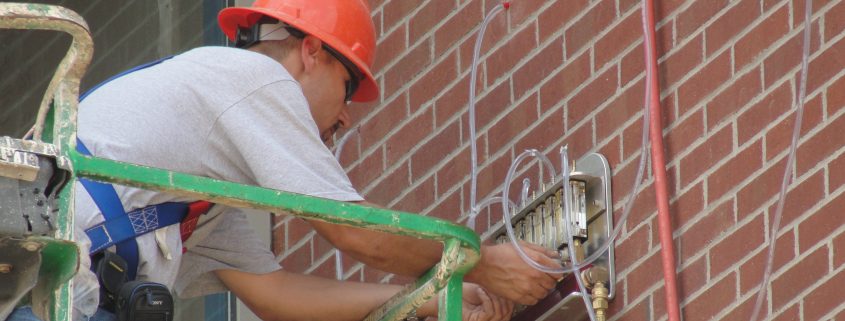
Although masonry wall systems are durable and capable of fulfilling their function for many years, defects are inevitable, usually becoming apparent as water intrusions within the building. These defects can arise from deficiencies in design, poor workmanship, inadequate project supervision, complicated cladding transitions, or a combination of these conditions. Some defects may show up soon after completion of the building while others may not develop for many years.
Brick masonry walls are primarily constructed using the following two methods: a masonry barrier wall or a masonry drainage system. A masonry barrier wall is formed when bricks are applied directly to a substrate. The most common method, the masonry drainage system, is a masonry wall that is designed with an air space between the outer wall (brick exterior) and the backup wall (inner wall) of usually 1 to 2 inches. This space serves two purposes. It provides a drainage space for water that penetrates the wall while allowing air to circulate in the space and dry moisture from water penetration and condensation. Newer construction techniques are dependent more than ever on quality workmanship, as newer designs often introduce multiple cladding systems that require complex waterproofing techniques. These design elements are particularly vulnerable to water intrusion problems.
The exterior masonry wall often referred to as the masonry wythe mainly acts as a rain screen. One of the biggest misconceptions by individuals not familiar with masonry construction is that the wall system is waterproof. Contrary to this belief, the brick and mortar joints actually act as sponges that draw water into the wall system. In a heavy, wind-driven rain, water, by design, will penetrate the masonry wythe. This water is then directed down the interior drainage space and collects at the thru-wall flashing, which consists of a rubberized asphalt or EPDM flashing material over a formed metal pan system. Common metal pan system materials are stainless steel, copper, and lead-coated copper. This water is then diverted back to the exterior via the weep holes located at the base of the pan system. A common defect arises when inner wall cavities are bridged with excessive mortar or debris at the base of the wall cavity during construction. If weep drains are omitted, placed at the wrong level, or blocked, water will likely accumulate and eventually find its way into the building. Excessive mortar will also cause water to bridge the drainage space and soak the backup wall’s moisture barrier. Improperly lapped or damaged moisture barriers will allow water to penetrate the backup wall system and eventually enter the building envelope.
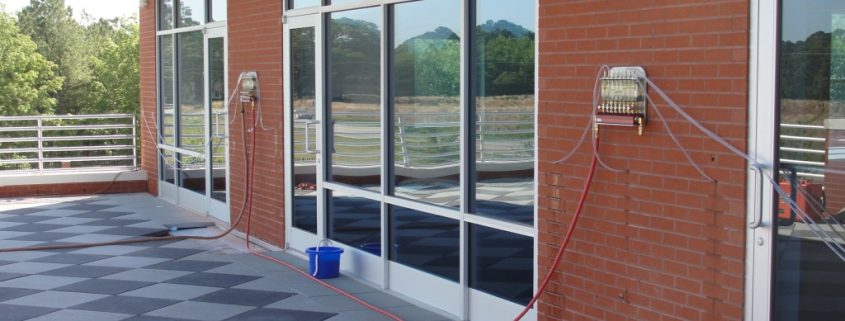
Water penetration through exterior masonry wall systems is a serious problem throughout the country. Identifying the cause and origin of water penetrations in concrete brick, clay brick, and stone cladding systems is often a difficult task. Many water intrusions are improperly diagnosed because the masonry walls are overlooked. ASTM has developed a standard to test the effectiveness of masonry drainage systems.
The ASTM C 1715 (Standard Test Method for Evaluation of Water Leakage Performance of Masonry Wall Drainage Systems) is a standard procedure for determining the ability of a masonry wall drainage system to collect water that penetrates the exterior wythe during rainstorms and direct this water back to the exterior via weep drainage systems. This test procedure requires drilling small ½-inch holes in the exterior brick façade. Plastic tubing is inserted to the inside edge of the brick wall system. Water is then applied at a low-volume, consistent flow into each of the holes. During the test, we document the ability or inability of water to exit the wall system via the weep drainage holes. This testing can be used to identify failures in the flashing systems, document cause and origin of water infiltration, determine the effectiveness of thru-wall flashing repairs, or provide quality assurance for new construction. Quality assurance testing is especially useful during the commissioning of a new building.
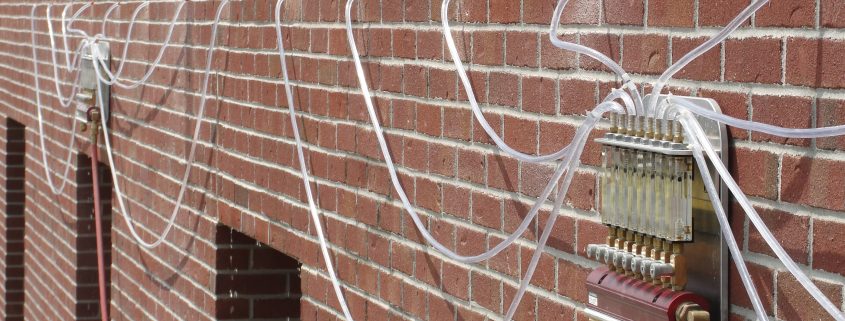
All of our masonry test equipment was custom built by us and conforms 100% to the ASTM standard. Each testing apparatus is calibrated every 6 months and properly maintained to ensure accuracy during onsite testing. Our newest commercial testing equipment was designed using custom made aluminum manifolds, individual precision valves, and specialized low volume flow meters. In addition, each test apparatus has flow-thru valves that allow the connection of multiple units together for larger test configurations and the ability to test at multiple elevations.
Water typically flows into the masonry wall cavity through separations between the mortar and the brick units. This can be due to bond separations, voids, and microscopic cracks. Water penetration will also occur, although typically to a lesser degree, due to absorption through the brick units and mortar. When the brick masonry drainage system is found to be deficient, many building owners, unfortunately, opt for a band-aid approach by applying a silane or siloxane sealer. Most sealers are not capable of bridging these types of gaps. Sealers will penetrate the masonry wall and repel water initially, but within a few months, they will begin to degrade at the surface, and water will again penetrate the wall system. Silicone-based sealers that can bridge larger gaps will change the appearance of the brick and mortar. In addition, sealers do not last forever and will become a maintenance item. Never rely on sealants to fix a leaky brick wall. It just won’t work. A masonry drainage system was designed to be just that, a drainage system. Identifying and repairing the root cause of a water intrusion is a much better approach.
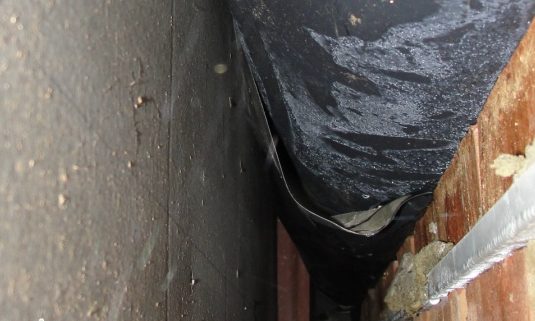
Many water intrusions that we identify in masonry wall drainage systems are found at the thru-wall flashing located at the base of the wall system, at window headers, and/or at each floor level in a multi-story building. These failures are due to penetrations from construction debris or improperly sealed lap joints and end dams. Another common failure is from excessive mortar between the brick masonry and the backup wall. Excessive mortar will bridge the drainage space and cause water to be directed down the backup wall moisture barrier. This may allow water to penetrate the building envelope at opportunistic locations.
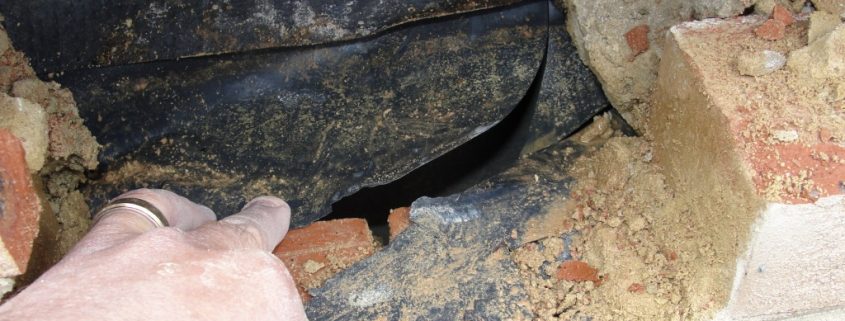
The good news is that today most masonry contractors are more cautious about keeping the drainage space free and clear of mortar and other debris during new construction projects. Drainage mat systems are also being utilized on most new projects. These help protect the base flashing from penetrations during construction. While these efforts may help to reduce many failures, quality assurance testing of the masonry wall drainage systems during initial construction will help alleviate costly repairs to a completed occupied building.
The time and expense of performing an initial, well-focused evaluation will save the building owner money in the long run and result in accurate repairs that extend the service life of a building.
BDG specializes in cause and origin water infiltration investigations utilizing numerous ASTM and AAMA testing standards. From forensic water intrusion services to new construction quality assurance (QA) testing, BDG has the experience, the equipment, and the personnel to handle all of your building diagnostic projects.
Give us a call to discuss your next project.

